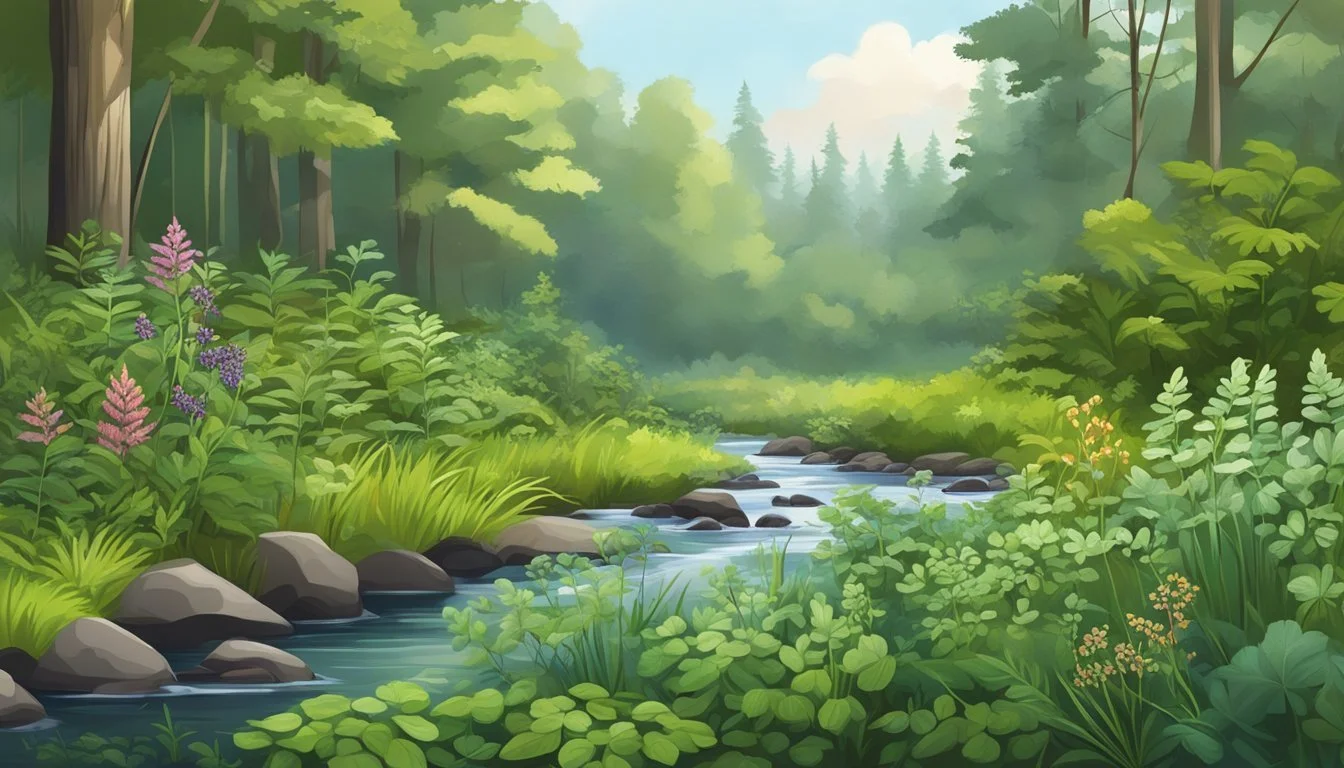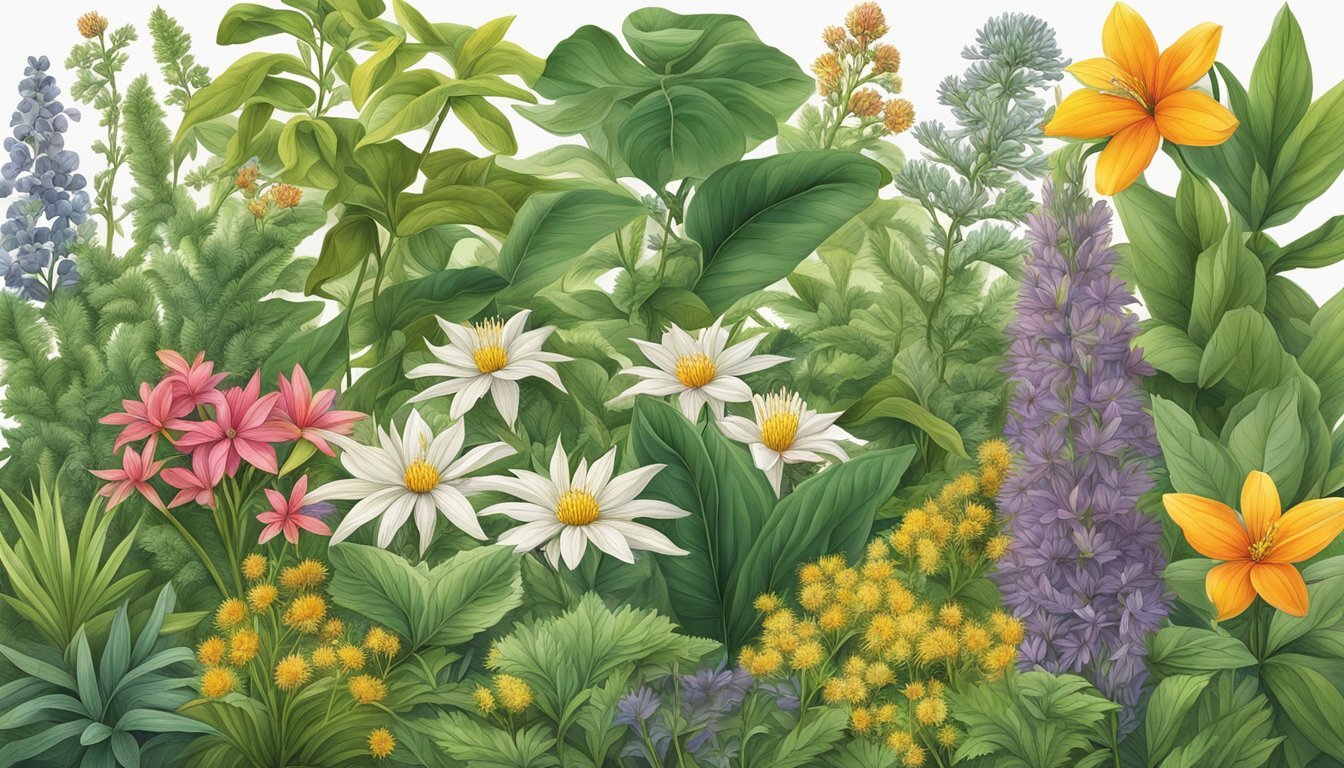Southeast Native Edible Plants
A Guide to Foraging and Cooking
The southeastern United States is rich in native edible plants that have nourished inhabitants for centuries. Wild Onion (Allium Canadense) stands out with its strong onion aroma and flavor, but caution is needed since its toxic look-alikes can be mistaken for edible plants. Another significant species is the Southern Magnolia (Magnolia grandiflora), a large tree recognizable by its grand stature and adaptability to sun and shade.
For those interested in foraging, resources like the Foragers Calendar offer great insights into when to harvest various parts of these plants. Hazelnut and Viburnum are notable natives that support diverse wildlife, making them beneficial additions to any landscape. Understanding and recognizing these plants can not only enhance your culinary adventures but also contribute to ecological balance in the region.
Exploring the edible plants of the Southeast can be a rewarding adventure. Dewberry, for example, provides a familiar taste similar to blackberries, making it a safe and delicious choice for beginners. With knowledge and careful identification, one can safely enjoy the abundant natural offerings of the region.
Understanding the Southeastern Climate and Ecosystem
The southeastern United States, including states such as Florida, Georgia, and Alabama, features a diverse climate and ecosystem. These areas are characterized by their subtropical and temperate zones, which heavily influence the native plant communities.
USDA Plant Hardiness Zone Map
The USDA Plant Hardiness Zone Map is essential for understanding which plants can thrive in the Southeast. Zones in this region typically range from 6 to 10. For instance, Southern Magnolia is found in zones 6-10 and can grow in full sun to partial shade. The map helps gardeners and foragers determine the best planting and foraging conditions, ensuring they select species well-suited to the local climate.
In Florida, the warmest state in the region, zones range from 8 to 10, which supports a wide variety of subtropical plants. Georgia and South Carolina feature zones from 6 to 8, balancing between temperate and subtropical conditions. Alabama and Mississippi also exhibit this range, creating a diverse habitat for many native species like wild onion and hazelnut.
Native Plant Communities
Native plant communities in the southeastern United States are incredibly diverse, owing to the variability in climate and ecosystem. Coastal areas, such as those in Florida, support mangroves and salt-tolerant species. Inland areas feature pine forests, deciduous woodlands, and wetlands.
Light and soil type vary greatly across the region. For example, magnolias and viburnums thrive in loamy, well-drained soils with partial shade. The moisture levels also play a crucial role, with Southern Magnolia preferring more moist conditions. In contrast, wild onions can grow well in various soil types, provided there's adequate drainage and sunlight.
Understanding these specifics helps in maintaining and cultivating native plant communities that contribute to the region's biodiversity and ecological stability.
Key Native Edible Plants of the Southeast
The southeastern United States is home to a diverse array of native plants that provide edible fruits, nuts, and other nutritious parts. This section highlights some of the most important and vibrant plant species found throughout the region.
Fruit-Bearing Trees
American Persimmon (Diospyros virginiana): This tree produces sweet, orange fruits that are commonly harvested in the fall. Persimmons require full sun and well-drained soil. Their fruits are high in vitamins A and C, making them a nutritious addition to the diet.
Pecan (Carya illinoinensis): Known for its buttery nuts, the pecan tree thrives in the southeastern climate. Pecan nuts are packed with healthy fats, protein, and antioxidants. The trees prefer deep, fertile soil and plenty of sun to produce their best yields.
Red Maple (Acer rubrum): While not primarily known for being edible, the inner bark of the red maple can be used in survival situations. This tree also provides beautiful red foliage in the fall, adding aesthetic value.
Berry-Producing Shrubs
Highbush Blueberry (Vaccinium corymbosum): This shrub is prized for its delicious, antioxidant-rich berries. Highbush blueberries need acidic soil and full sun to partial shade. They are often found in moist woodlands and swamps.
American Cranberry (Vaccinium macrocarpon): Found in bogs and wetlands, these berries are tart and commonly used to make juice and sauces. Cranberries require acidic, consistently moist soil and can thrive in cooler climates.
Edible Groundcovers
Wild Strawberry (Fragaria virginiana): This groundcover produces small, sweet berries that are excellent fresh or used in jams. Wild strawberries prefer sunny locations with well-drained soil and can often be found in meadows and forest edges.
Pink Purslane (Portulaca pilosa): Though many consider it a weed, pink purslane has edible leaves and stems. It grows in sandy, well-drained soils and is drought-tolerant, making it easy to cultivate in a variety of conditions.
Herbaceous Edible Plants
Wild Onion (Allium canadense): Known for its strong onion flavor and smell, it can be used much like cultivated onions. Important to note, only consume if it has a strong onion odor to avoid toxic look-alikes.
Pawpaw (Asimina triloba): This plant bears fruit that tastes like a mix of banana and mango. Pawpaw trees grow best in rich, well-drained soil and can tolerate partial shade, often found in understory environments.
Common Blue Violet (Viola sororia): This plant’s leaves and flowers are edible and can be added to salads or cooked dishes. It prefers moist, shaded environments, often found in forests and along stream banks.
Plant Identification and Foraging Tips
Accurate plant identification is crucial when foraging for edible plants in the Southeast. It ensures safe consumption and helps preserve the environment's ecological balance through sustainable harvesting practices.
Identifying Common Edible Species
Recognizing edible plants requires familiarity with their distinct features. For example, the southern magnolia (Magnolia grandiflora) is notable for its large, glossy leaves and fragrant white flowers. This tree thrives in full sun to partial shade and can grow up to 80 feet tall.
Foragers can also find dewberries, which resemble blackberries. Look for their low, trailing vines with thorny stems and bright, dark berries.
Prickly pear cactus is another edible native, recognizable by its flat, spiny pads and colorful fruit. Its pads and fruits are both edible, growing well in arid conditions.
Sustainable Harvesting Practices
Sustainable harvesting ensures the longevity of wild plant populations. Foragers should take only what they need and leave enough for the plants to reproduce and for other wildlife to feed on.
Avoid harvesting from the same plant repeatedly to prevent stress and depletion. For instance, when picking prickly pear cactus fruit, wear gloves to handle the spines carefully, and leave some fruit to aid in the plant's propagation.
Always forage in areas where plant populations are abundant, and avoid those where they are sparse. This practice helps maintain ecological balance and the availability of edible plants for future generations.
Use a plant identification guide to confirm the species before harvesting, ensuring safety and minimizing environmental impact.
Medicinal and Nutritional Benefits
Native plants in the Southeast offer notable medicinal and nutritional benefits, playing a crucial role in fostering health and wellness. Some of these plants aid in heart health, managing cholesterol levels, and strengthening bones.
Native Plants with Health Benefits
Wild Onion (Allium Canadense)
Wild Onion is renowned for its strong onion aroma and flavor. It contains antioxidants and vitamins that boost immune function. It may help lower blood pressure and improve heart health.
Black Cohosh (Actaea racemosa)
This flowering perennial is used primarily for women's health, particularly in managing menopausal symptoms. It's known for its anti-inflammatory properties and potential benefits for bone health.
Broad Leaf Plantain (Plantago major)
Commonly found in the Southeast, Broad Leaf Plantain is used for its anti-inflammatory and wound-healing properties. Its leaves can be used topically or ingested to help manage cholesterol levels and support digestive health.
Wildlife-Friendly Gardening
Creating a garden that attracts and supports wildlife involves choosing plants that serve as food sources and habitats for various species. This practice not only benefits the local ecosystem but also enhances the beauty and functionality of the garden.
Plants That Attract Pollinators
Selecting plants that produce nectar is essential for attracting pollinators like bees, butterflies, and hummingbirds. Southern magnolia (Magnolia grandiflora) and hazelnut are excellent choices for southeastern gardens. These plants provide nectar-rich flowers that are particularly attractive to bees and butterflies, including monarch butterflies.
To create a pollinator-friendly garden, plant a variety of flowers that bloom at different times of the year. This ensures a consistent food supply for pollinators. Spring bloomers like wild indigo (Baptisia australis) and summer-flowering threadleaf coreopsis (Coreopsis verticillata) are great options. Diversity in plant selection not only supports a wider range of pollinators but also enhances the resilience of the garden ecosystem.
Creating a Habitat for Wildlife
Wildlife-friendly gardening involves more than just planting for pollinators. Incorporate plants that provide shelter and food for birds, insects, and other wildlife. Pawpaw (Asimina triloba), known for its large edible fruit, also serves as a host plant for the larvae of the zebra swallowtail butterfly.
Designing mixed plantings of trees, shrubs, and perennials creates a layered habitat that supports a variety of species. Birds benefit from trees like wild persimmon (Diospyros virginiana), which offers fruits and nesting sites. Viburnum species provide berries and support many caterpillars, forming an essential part of the food web.
Adding features like bird baths, logs, and rock piles can enhance the habitat value of your garden, providing water, hiding spots, and breeding grounds for various wildlife. This holistic approach creates a thriving environment that supports both plant and animal life.




